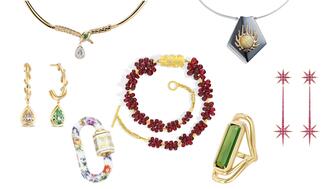The couple pleaded guilty to concealing at least $127 million in cash transactions at its precious metals businesses.
Creative Connecting: Social Media Ethics in a Highly Charged World
Duvall O’Steen and Jen Cullen Williams share advice on navigating politics, negative reviews and online trolling in these difficult and volatile times.

Add to that the widespread feelings of uncertainty and vulnerability in these unprecedented times and it creates a highly charged world.
With the rise of user-generated content and social justice via social media, it is now more important than ever for brands to mind their proverbial Ps and Qs.
So, how can jewelers navigate the challenging world of online reviews, negative social media comments and politics?
First and foremost, be kind.
Remember that customers are communicating with you because they like and follow your brand.
Their comments, if viewed with an open mind, can help improve your business and often bring to light problems you may have overlooked.
Like the gems we cherish, let your inner sparkle shine light on the problem and help you find an agreeable solution in a timely manner.
A number of social media service providers, including Agorapulse, Hootsuite and Buffer, all recommend responding to unhappy customer posts, comments or reviews within two to three hours if possible, even if only to say you will look into it and reply in greater detail shortly.
Also, understand the law and what you can and cannot say to the public about your jewelry.
According to Tiffany Stevens, president and CEO of the Jewelers Vigilance Committee: “Online brand management is everything these days as we’re in a digital-only reality. To have a healthy social media presence, jewelers should be aware of the nuances of how to advertise jewelry.”
Reviews: How to Handle Negative Online Feedback
Negative reviews on Google, Yelp or Facebook can be disheartening.
We put so much time, effort and energy into building our bands, and yet, in less than 60 seconds, a consumer can tear it down with a damaging review.
The good news is that there are constructive ways to overcome such criticism.
“When it comes to negative reviews, my No. 1 rule is to take a breath and do not reply right away,” says Allyson Bainbridge Riccardi, brand, content and strategy development consultant at Bambolina NYC. “And No. 2 is to do your homework.”
She recommends allowing emotions to settle by taking the time to review the situation with your team. Ask if anyone remembers the customer or can help explain what prompted such a negative reaction.
If you discover the situation was not handled properly,
“If it is a valid complaint, even if you don’t like what was said, don’t delete or block the user. Customers are very attuned to the way you handle problems, and they will be suspicious if your profile only displays glowing, five-star reviews.”
Remember the old adage “the customer is always right” and take caution not to make the customer “wrong” in your reply.
Stay true to your company’s core brand values in every message to your customer; unlike robotic replies, authenticity adds a genuine, human element to the conversation.
Keep in mind that other customers may be watching to see how your business responds to the complaint.
You have a chance to gain the respect of many others by coming to a positive solution with the unhappy reviewer. And if no such resolution can be found, at least you earn points in the eyes of other would-be customers for having tried.
Unfair reviews are common when a customer has unrealistic expectations or holds a company accountable for things outside of its control, like the weather.
Harvard Business Review recently published research showing how companies can make the best of bad reviews and even turn them to their advantage.
The authors of the article suggest embracing bad reviews in creative ways, giving the example of how one company took an obviously biased review and cleverly used it in an ad campaign.
Interestingly, they also recommend sharing employee spotlights (“meet our employee of the month,” or “get to know your jeweler/designer”) because putting a human face to the brand makes it less likely to be targeted.
Lastly, be sure to garner as many positive reviews as possible. Often, we forget to ask our happy customers to review our brands or businesses.
Research shows that because the average consumer expects good customer service, happy customers are less inclined to review a business.
Encourage all staff and team members to actively solicit positive reviews from satisfied customers, especially shortly after a damaging review.
Reviews often show up in chronological order, so using grassroots efforts to elevate good reviews above a bad one can help to effectively bury the negativity or at least make it less impactful.
Comments: How to Deal with Negative Ones on Social Media
In these challenging and emotional times, customers who follow your brand on social media feel entitled to share their angst, negativity or angry comments on your social media posts.
Unless the comment contains profanity, defamation or name-calling, avoid deleting the comment and/or blocking the follower.
After all, you’ve spent a lot of time and money to engage with your followers. Try to look at their comments as another way to connect.
According to Christina Fumia, president and CEO of Avant-Garde Marketing & Communications, “Negative social media comments come no matter what you do. It is how you handle them that makes the biggest difference and helps set you apart amongst your competitors.”
Fumia recommends full transparency.
“Old-school strategy used to say that you should ask the customer to send you more information via email or in a more private space. But the brands winning the reputation management trophy these days are the ones that show full transparency. People want to see exactly how the issue was resolved.”
Remember that everyone can see the exchange in the comments, so be compassionate and try to fix the problem.
Always maintain a sincere, human approach. Avoid copy-and-paste replies or standard language that can come across cold and robotic.
“Provide excellent customer service that shines so brightly that other readers will forget the issue and just focus on your amazing customer service,” says Fumia.
Riccardi advises taking the opportunity to turn the negative into a positive.
“Even if the user has said something nasty or has an unwarranted complaint, always acknowledge their feelings and perspective, and politely point them in the right direction in resolving their problem. ‘Oh, you hate yellow gold? Sorry to hear that, we also carry this in platinum, and we’d love to know what kind of jewelry you’d like to see more of!’”
Upon resolution of the problem, Fumia suggests asking the customer privately (via email or direct message) if they would be willing to write a review or recommendation on your most popular social media platform to talk about the way the issue was handled.
Politics: How to Avoid Divisive Topics or Explosive Content
An interesting development of 2020 is that it now appears to be unacceptable to avoid hot- button political subjects altogether.
Riccardi concurs.
“Six months ago I would have said that it is generally a terrible idea for brands to talk about politics or controversial, polarizing topics on social media. However, we have experienced a sea change recently and to completely ignore the social issues that are gripping our country now feels tone-deaf.”
She recommends brands avoid posting content from political parties, or polarizing movements or organizations.
That being said, showing solidarity with a cause you support can be OK if done sensitively. Use short-term 24-hour stories on Instagram and Facebook to share about causes or charities you support, avoiding inflammatory language and keeping the tone positive. And if sharing articles that impacted you, be sure to vet them fully before sharing as stories.
But if the social media account is about your business, Riccardi recommends keeping the permanent posts about the business, “and that can mean showing your employees wearing masks or not, but not posting directly about your personal political affiliations.”
For followers who post political comments on your posts, avoid “liking” their comments as it may be interpreted by other readers as agreement.
Rather, reply to the comment with neutral language. Riccardi suggests a simple “thank you for your opinion.”
She also wisely reminds us to avoid deleting acceptable comments just because we don’t agree with them: “Every comment is valuable because it affects your engagement, which affects the algorithm, which affects who is seeing the content.”
For brands to avoid inadvertently being linked to controversial or divisive content as an advertiser, Facebook recently announced two new brand safety controls, allowing in-stream advertisers to choose content-level exclusions from gaming, news, politics and religious/spiritual content.
Facebook has many other brand safety controls to consider, and best practice guidelines available here.
Be wary of sharing incendiary news articles, as well.
If you choose to share media articles, take the time to vet them and ensure their validity before sharing or reposting.
Snopes.com and FactCheck.org are great resources for evaluating sensational headlines.
And remember that all human beings, since the beginning of civilization, have had an affinity for jewelry.
Many of your customers may not share your political ideology or your civic values but at the end of the day, we all share a common bond in our love of jewelry, adornment and gift-giving.
In our increasingly divided society, focusing on what we have in common is crucial.
Legal Ramifications: Limitations and FTC Guidelines
Finally, it is also important to understand the law and what you can and cannot say to the public about your jewelry on social media—in posts, stories, videos and replies to reviews/comments.
According to the JVC’s Stevens: “Our industry has some hyper-specific rules from the Federal Trade Commission (FTC) that must be followed. An easy breakdown can be found here.”
The primary goal of the FTC guidelines is to protect consumers from false advertising.
This becomes especially relevant for social selling. If you are setting up shoppable accounts on Instagram and Facebook, take the time to learn the specific language that is acceptable.
When replying to consumer comments or reviews, avoid short cuts or lingo that becomes questionable and/or leads to confusion.
As an example, if you are selling lab-grown diamonds, there are clear and acceptable phrases that can be used to describe them in the posts and in social media advertising. Those same language limits apply to comments and social media messaging with your customers.
“Beyond the jewelry-specific rules, there are general social media requirements for how any online business discloses and talks about things like environmental/green claims and also how any influencer your brand is working with needs to create their posts,” says Stevens.
Legally, when replying to negative reviews and/or comments, the JVC advises sticking to the facts.
“If you are in the situation of having unsavory comments or feedback, you’re not alone,” she says. “The internet is like that. We’ve found it’s best to respond in a factual manner to any real complaints. Consumers appreciate transparency.”
Should the negative comments be untrue or get out of hand, brands are protected from fraudulent claims by consumers.
Stevens recommends contacting the JVC in such scenarios, via JVCLegal.org or at 212-997-2002.
“If you feel you are being harassed or someone is posting fake negative reviews, it’s worth reporting that to JVC. We work directly with the FTC on issues of online fraud.”
Lastly, if you are a large company with junior staffers or an agency managing the day-to-day social media monitoring, have a policy in place that stipulates when to get senior management involved.
Sometimes, a word from the president or CEO can go a long way toward making the customer feel valued and/or heard.
In summation, Fumia reminds us: “Remember, problems are temporary. How you handle the problem and how you treat your customer are the things that stick with people. Everyone is watching, and your recovery is what matters the most.”
The Latest

Consumers shared concerns about prices, inflation, tariffs, trade, and politics in the survey’s write-in response section.

In February 2026, the auction house will move its headquarters to the former Steinway Hall, a neoclassical landmark on Billionaires’ Row.

How Jewelers of America’s 20 Under 40 are leading to ensure a brighter future for the jewelry industry.

The new show will take place Jan. 23-25, 2026.


The former BHP Billiton leader and Gemfields chairman is remembered for his influential leadership throughout his 50-year mining career.

The LVMH-owned brand has partnered with the costume design union to revamp its award for 2026.

Roseco’s 704-page catalog showcases new lab-grown diamonds, findings, tools & more—available in print or interactive digital editions.

The luxury titan inked a deal to acquire an initial minority stake in the jewelry manufacturer with a pathway to full ownership by 2032.

The company’s curation of unsigned vintage and estate jewelry debuted at the Bloomingdale’s in Costa Mesa, California.

In the recent multi-shipment seizure, CBP also found counterfeit Audemars Piguet, Moncler, and Chrome Hearts items.

Helzberg’s Chief Retail Officer Mitch Maggart shared details about its tests of a new store concept rooted in an elevated luxury experience.

Jewelers of America execs and National Jeweler editors discuss tariffs, the sky-high gold price, and the engagement that broke the internet.

The luxury goods company said founder Ippolita Rostagno will remain at the brand’s helm.

Laura Burdese, who joined the Italian luxury brand in 2022, will take on the role in July.

The National Jeweler editors revisit the most noteworthy industry happenings and design trends from 2025.

Need a gift for the cat lover who has everything? Look no further than our latest Piece of the Week.

It purchased the “Grosse Pièce,” an ultra-complicated Audemars Piguet pocket watch from the ‘20s, for a record-breaking price at Sotheby’s.

The lab-grown diamond grower now offers custom engagement and fashion jewelry through its Kira Custom Lab Jewelry service.

Chandler got his start at Michelson Jewelers and has served as DCA president and CEO since 2001. He will retire at the end of the month.

The boutique is slated to open this week inside Terminal 8, offering pre-owned Rolex watches and more to international travelers.

Sponsored by Digital Monitoring Products

The special-edition egg pendant ingested in a New Zealand jewelry store was recovered after a six-day wait.

Associate Editor Natalie Francisco plays favorites with Piece of the Week, selecting a standout piece of jewelry from each month of 2025.

The “Love and Desire” campaign is inspired by the magic that follows when one’s heart leads the way, said the brand.

Two awardees will receive free tuition for an educational course at the Swiss lab, with flights and lodging included.

Berta de Pablos-Barbier will replace Alexander Lacik at the start of January, two months earlier than expected.




























